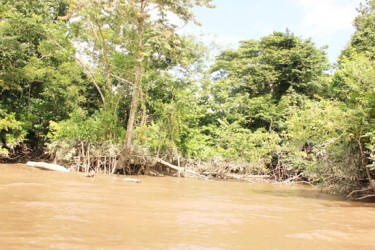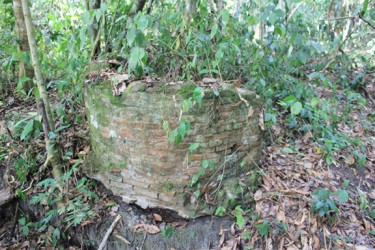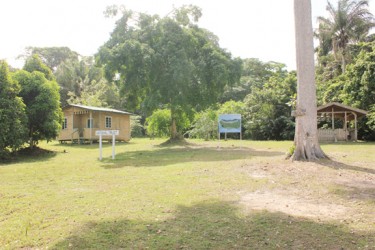All that is left of most of the sites where the Berbice Uprising took place 250 years ago is bush, bush and more bush.
And if you ask the people who live in those areas about the places named in the records, the most they will tell you is that they saw a “Dutch tomb” somewhere, or you might find “Dutch bottles” somewhere else.
Two hundred and fifty years is a very long time, but the rising, one of the major ones of the Caribbean is of such significance that one might have expected more knowledge among the locals.

Perhaps it is because this revolt does not feature in the local school curriculum or because no attempts were made to preserve some of the sites, so raising consciousness about the heritage. Or perhaps it is because it happened in the Dutch colonial period, and the traditions about it did not cross the language barrier into English. All those who used to speak Berbice Dutch, the lingua franca of the river in the 18th, 19th and early 20th centuries, have now passed on.
Unfortunately, if you ask those who live in the Berbice River close to the revolutionary sites they would look at you in puzzlement if you mention names such as Hollandia or Vigilantie, for example.
“Well it is where a Dutch plantation and it was…” you might begin to say, when you will be quickly cut off with, “Oh, I think ah know where it is, because people say a Dutch tomb been deh.”
“You know I never know this place name…” one man said to Stabroek News as he pointed to where the Lelienburg plantation was once located. He pointed out the site because he recalled stumbling on a broken Dutch tomb some years ago.
“But to tell you the truth to find deh tomb again you have to give me one or two days because is bare bush now,” he said.
He did not have to tell us this because all that was visible of Lelienburg was thick bush, as was the case with Hollandia too.
The only location that is preserved and where one can actually see remnants of Dutch occupation is at Fort Nassau, once the headquarters of the Dutch in Berbice, which was where Coffy had his headquarters during the Berbice uprising.
This is because the National Trust of Guyana took control of the site, cleaned it up and appointed a caretaker. There had once been a caretaker there, appointed by the British in colonial times, and during the mid-1970s, the National Service did a thorough job cleaning up the site. After that, however, the bush gradually reclaimed the area, and bottle-hunters damaged some of the remains.
The two-man team from this newspaper recently journeyed up to the Dubulay Ranch which is situated partly on land where Plantation Peereboom once stood. All that can be found there now is a Dutch tomb and maybe a few bricks, although even these were difficult to locate.

The residents of the titled village on the Wiruni know nothing or very little of the historical importance of the location, and one of the employees of the ranch, who said he had only lived there for 18 months, told us that he knew more about the rebellion than the people living in the area.
The Captain appeared puzzled when approached by this newspaper to talk about the fact that it would soon be 250 years since the rising, and he quickly asked whether that was the only reason the newspaper was visiting since the area had “a number of burning issues that need to be highlighted in the media.”
One of those issues was the poor state of the St Lust Primary School building and this school sits on land which at the time of 1763, was attached to the Dutch Reformed Church, not that far from Hollandia and Lelienburg, but its population knows nothing about how Coffy and his men managed to control the plantations for over a year.
And so it was at Hollandia too, where no one knew much about the uprising but one lady said she heard a “tomb get somewhere over deh,” pointing vaguely to the opposite side of the river from her home.” She was later joined by an older woman who joined the brief discussion but admitted she herself knew nothing of the uprising.
“You gat to ask the older folks you know, they might know better,” she said with a small smile.
At Fort Nassau some of the persons appeared to have a little knowledge of the uprising.
The caretaker of what is now categorised as a heritage site, Mathew Grimmond, was all buoyed up to give us a historical background of the uprising, but he focused more on how strong the slaves must have been to have carried out the revolt. He was ready with a brochure and was very happy to take this newspaper’s team to the various sites that have been preserved, although it is mostly brick foundations that can be seen nowadays.
There are also many broken bottles in evidence, and as mentioned above, the area was once known as a popular place where persons from around the location and from neighbouring communities would search for Dutch bottles and other Dutch artefacts which they then sold.

As a young girl I spent many years opposite the heritage site at my grandmother’s home and while I knew nothing of the uprising − I learnt later through reading and during my senior years in secondary school − but I heard many stories (some scary) about the ‘Dutchman.’ I vividly recall observing in wonder as men I knew would go deep down into the water and return with bottles and other items. Some also used what we called ‘testers’ (a long fine piece of metal stuck into a wooden handle) which they used to push into the mud and when they heard the sound of a ‘clink’ they would carefully dig around until they retrieved the prized item.
Now there is no diving and testing for bottles (most have gone by now) and the residents seemed to be very proud of the heritage site which brings a steady stream of visitors.
Dageraad and Vigilance (Vigilantie) are located some miles from Fort Nassau, but like many of the other places there is no one living in those areas and they have become overgrown by bush.
And so while those on the coast will be observing the 250th anniversary of the Berbice uprising those who live in proximity to the plantations where the fighting took place have scant interest in it and some might not even be any the wiser about it.





